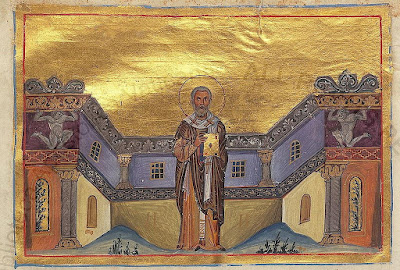The Rebirth of the First Monastery in the Holy Land
Wildly beautiful, with sheer white cliffs and a lush green valley, Wadi Faran is the site of the very first monastery established in the Judean desert. St. Chariton, an ascetic from the 3rd century, found this place an ideal site for prayer and contemplation. Historians now say that this valley may even have been visited by Our Lord Jesus Christ.
Massive white rocks and sheer cliffs overlook a ravine. Directly below the lavra, a spring feeds a stream as eddying pools of water give life to flowering bushes and trees.
Birds dive straight down from the terrifying heights of the cliffs over-head, sweeping upward just before reaching the bottom of the ravine. Conies scurry about their lairs (Psalm 103 [104] :18), pausing to gaze curiously at visitors.
Across the valley, an enormous mountain of striated rock, rippling like a sea of stone down towards the spring and dazzling in the morning sun, hides over a dozen caves.
These old monk cells dot the cliff walls,the largest of which served for centuries as a church. Access to this cave church is provided by a ladder passing through a narrow hole cut through an enormous slab of rock.
The church is a small space, with uneven walls and ceilings covered with centuries of soot. It is connected by low passageways to other caves, where monks ate, slept and prayed. Some of these cells were accessible only by rope ladders, which, when drawn up, guaranteed that their monastic solitude would not be disturbed.
The Russian Ecclesiastical Mission is bringing this lavra back to life. Not only monastics but pilgrims can once again sense the very same breathtaking and sublime beauty that St. Chariton and so many holy ascetics experienced for hundreds of years.
The Life of St. Chariton
In the year 275, a Christian named Chariton, imprisoned for his faith in Iconium, was freed and set out on a pilgrimage to Jerusalem. Before reaching his destination, however, he was abducted by bandits and brought to a cave in Wadi Faran.
That night, the kidnappers died mysteriously. According to tradition, a snake poisoned the abductors' wine with its venom, which they drank along with their doom. Chariton decided to stay in that very cave as a hermit. Monastics gathered around the wise ascetic, already known as a miracle-worker, and the first monastery in the Judean desert was born. Each monk lived in his own cave and met weekly for prayer.
Chariton soon fled from his followers in search of solitude-in this way, he was to found two more monasteries. His love for Wadi Faran, however, lasted throughout his life, and he was laid to rest there, according to his wishes. His tomb is found just below the caves where he first became a hermit. From then on, the monastics who gathered in this region numbered between 10-14,000, and the Patriarch of Jerusalem appointed an archimandrite just for this region.
Rediscovery of the Lavra
In the 12th century, the Russian pilgrim Abbot Daniel visited the Holy Land (the very Daniel who first lit the flame at the Tomb of Christ for the Land of Russia). He wrote of Wadi Faran, "...And there is a monastery nearby on the river Efam, near the sea of Sodom, in the mountains of rock, a great desert, wide and fearsome, waterless and arid...and beneath it is a labyrinth of rock, vast and exceedingly terrifying." St. Chariton's monastery was also, in his words, "Beauty amongst the mountains of rock, surrounded by a city..."
The Holy Land was ravaged by Saracens, Persians and "Crusaders", and the era of great monasteries was at its end. By the 16th century, only one monastery remained in Palestine, that of St. Savvas the Sanctified.
Archimandrite Leonid (Kavelin), head of the Russian Ecclesiastical Mission, took a small group of monks in 1865 to search for the monastery on horseback. There was no longer a city surrounding the site, nor was there a road. The pilgrims' horses were left behind and they continued on foot. They traced the stream leading to the Dead Sea until they found a cave with seven openings, the very cavern of Chariton's salvation. Before the First World War, a delegation of Russian monks from Mt. Athos under the guidance of Fr. Panteleimon purchased the cave of St. Chariton along with some surrounding land. The monks reestablished a lavra there, living in the caves, gathering as they did in St. Chariton's time, only once a week for prayer.
However, the beautiful Athonite-style church they built was destroyed during the war (tesserae from the mosaics can still be seen strewn on the grounds). One of the monks, Fr. Gerasim, patiently began restoring the lavra, and built a small clay domicile. His intention was to rebuild the lavra as a pilgrimage site, but times were difficult, and Russians could ill afford to make the pilgrimages they once made by the thousands. Fr. Gerasim then sold the property to the Russian Ecclesiastical Mission. The Society of St. Chariton was formed to care for the site, but in 1948, the lavra again burned down.
Two monks re-established a presence there again in the 1970's. Tourists and soldiers, attracted by the overwhelming beauty of the valley, flooded the area. Desiring solitude, the monks left St. Chariton's. The monastery's gates were then broken down, the iconostasis and books stolen.
The Russian Ecclesiastical Mission appeals for your help in the restoration of St. Chariton's lavra. We hope, also, that you make a pilgrimage to this magnificent and holy site, walking the paths Our Lord Himself may have walked and visiting the caves where so many monastics prayed ceaselessly for centuries.

































